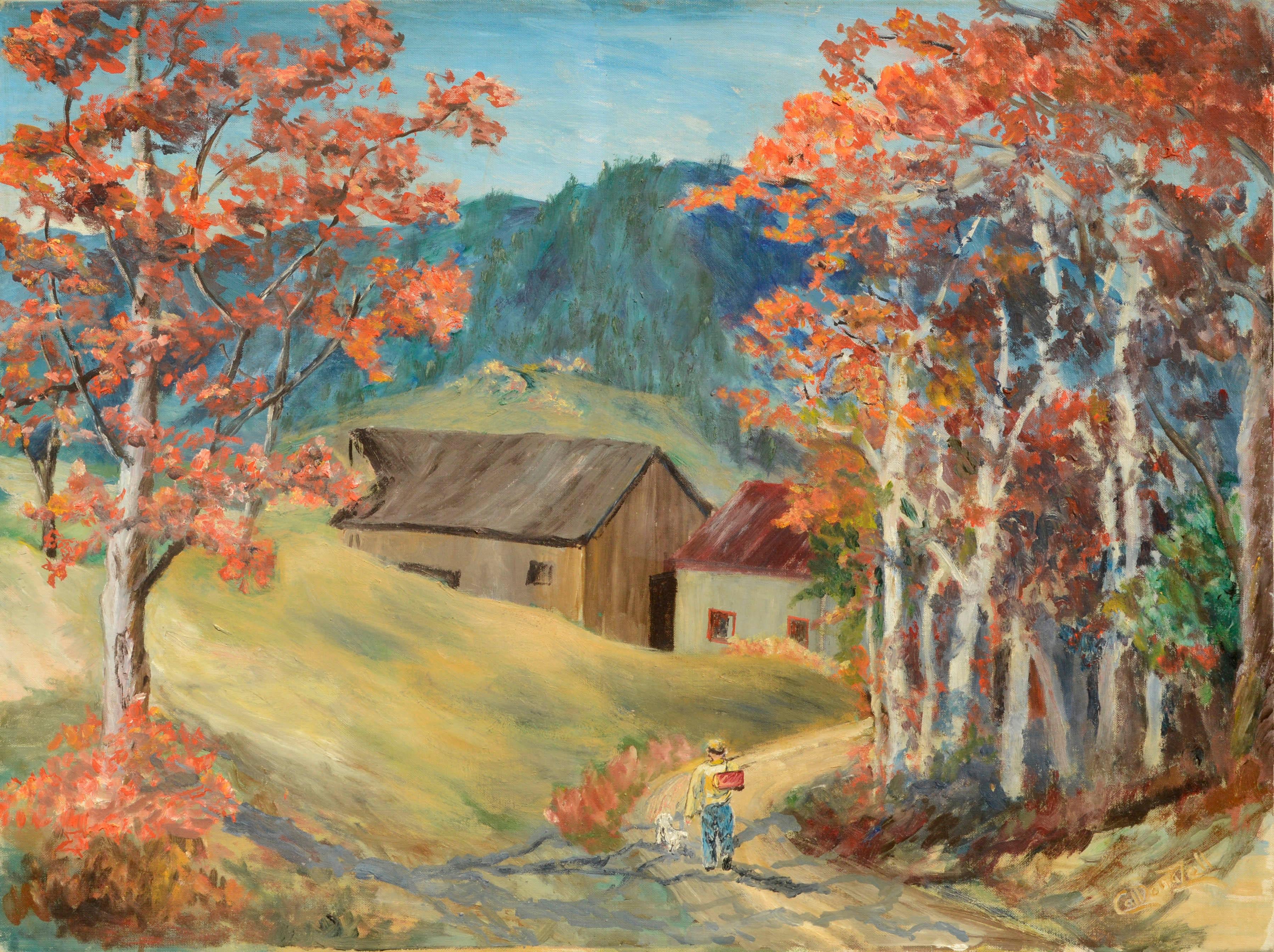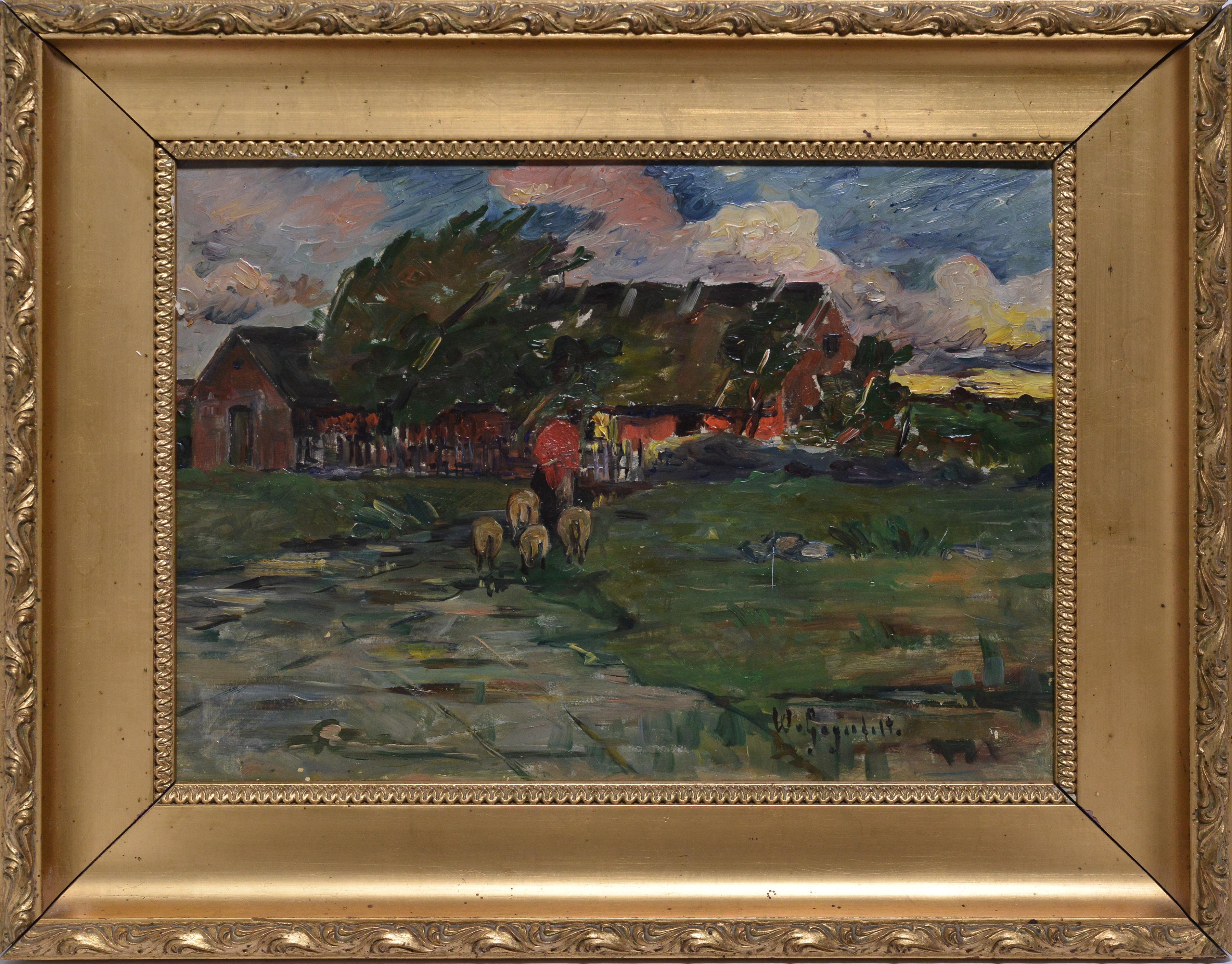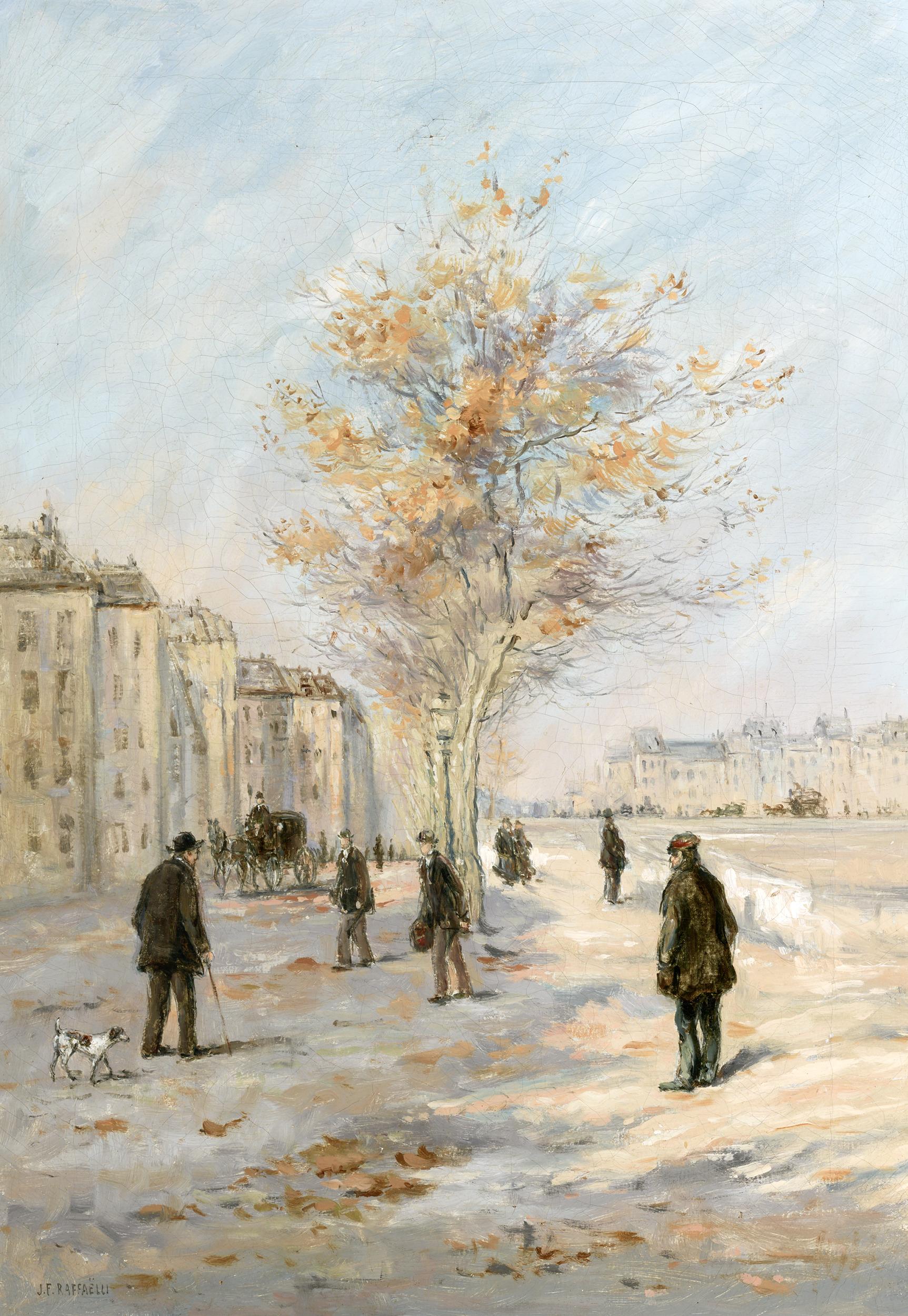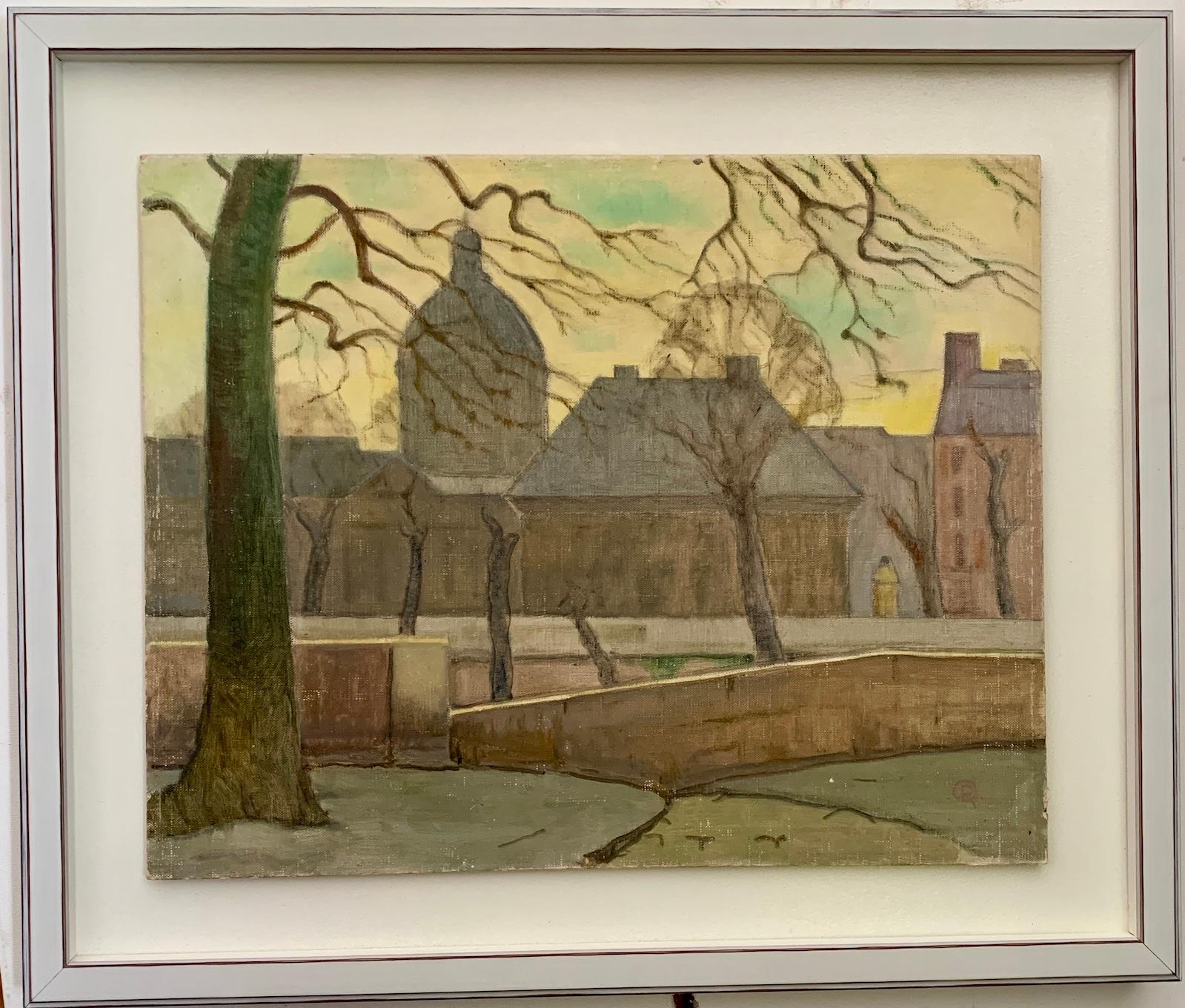Items Similar to "Imagination Towers Emptily" Oil painting
Want more images or videos?
Request additional images or videos from the seller
1 of 2
Todd Carpenter"Imagination Towers Emptily" Oil painting2020
2020
About the Item
Todd Carpenter's (US based) "Imagination Towers Emptily" is an oil painting that depicts a black and white landscape of vast plain leading to a distant city radiating with light
Bio/artist statement:
Todd Carpenter is a Los Angeles based artist who uses black and white paint to explore the perception of space and beauty. Carpenter's formal education is in science - he holds a MS in Neuroscience from UCSD and a BS in Psychobiology from UCLA - and he brings this background into service when making art. His paintings explore the mechanisms of perception and aesthetics, examining among other things how the depiction of light can impart realism and convey emotion. Like his paintings bridging art and science, Carpenter's career has similarly straddled the two fields, and he has taught subjects ranging from neuroscience and environmental science to photography and painting.
Artist Statement
As a painter, I am particularly interested in how the depiction of light contributes to our experience of paintings. Painting, as with any visual art, is obviously dependent on light. But painting can also have a more specific connection in that the accurate depiction of light is crucial for achieving realism. Realism in paintings largely arises from the portrayal of depth - perceiving a painting as being realistic is equivalent to seeing its subject as existing in more than just the two dimensions of the picture plane - and one of the mechanisms by which humans perceive depth is through lighting cues. Light creates features such as shading, shadow, and contrast that tell us about the three-dimensional arrangement of our surroundings, and artists often use these features to impart realism to paintings.
Light also factors in to the emotional impact of paintings. The differential illumination of our surroundings can evoke different moods, as evidenced by the influence sunsets, candlelight, and darkness can have on us. Such effectssuggest that our perception of light could be tied to primitive instincts, with light signaling factors such as shelter, nightfall, and warmth, which were once crucial for survival. The depiction of light in paintings can potentially tap into these primitive responses, to contribute to the emotional impact of the painted scene.
One reason why I paint in grayscale is that it is suited for the portrayal of light. The lighting features that our brains use to perceive depth are based on color brightness rather than hue, and the parts of the brain that process depth work in black and white, separate from the areas that encode the colors and details we use to distinguish objects. By painting in grayscale I am attempting to interact specifically with this part our visual system, with the hope of imparting a degree of realism and perhaps even conveying some of the emotional significance that light can imbue.
It is through light that we see the world, but light itself is also seen, with an impact independent of the subjects transmitted by its waves. Light is both the crisp contrast of a back-lit forest and the gray haze of an industrial landscape, and the perceptual power of light is what communicates the atmosphere of such places. This ability of light to effect us is the principle subject of my paintings.
- Creator:Todd Carpenter
- Creation Year:2020
- Dimensions:Height: 6 in (15.24 cm)Width: 12 in (30.48 cm)
- Medium:
- Movement & Style:
- Period:
- Condition:
- Gallery Location:Denver, CO
- Reference Number:1stDibs: LU130826893782
About the Seller
5.0
Platinum Seller
These expertly vetted sellers are 1stDibs' most experienced sellers and are rated highest by our customers.
Established in 1990
1stDibs seller since 2019
517 sales on 1stDibs
Typical response time: <1 hour
- ShippingRetrieving quote...Ships From: Denver, CO
- Return PolicyA return for this item may be initiated within 7 days of delivery.
More From This SellerView All
- "Darkness Rises" Oil paintingLocated in Denver, COTodd Carpenter's (US based) "Darkness Rises" is an oil painting that depicts a city in the distance glimmering in the darkness with a few sparse and leafless trees vaguely blocking its view Bio/artist statement: Todd Carpenter is a Los Angeles based artist who uses black and white paint to explore the perception of space and beauty. Carpenter's formal education is in science - he holds a MS in Neuroscience from UCSD and a BS in Psychobiology from UCLA - and he brings this background into service when making art. His paintings explore the mechanisms of perception and aesthetics, examining among other things how the depiction of light can impart realism and convey emotion. Like his paintings bridging art and science, Carpenter's career has similarly straddled the two fields, and he has taught subjects ranging from neuroscience and environmental science to photography and painting. Artist Statement As a painter, I am particularly interested in how the depiction of light contributes to our experience of paintings. Painting, as with any visual art, is obviously dependent on light. But painting can also have a more specific connection in that the accurate depiction of light is crucial for achieving realism. Realism in paintings largely arises from the portrayal of depth - perceiving a painting as being realistic is equivalent to seeing its subject as existing in more than just the two dimensions of the picture plane - and one of the mechanisms by which humans perceive depth is through lighting cues. Light creates features such as shading, shadow, and contrast that tell us about the three-dimensional arrangement of our surroundings, and artists often use these features to impart realism to paintings. Light also factors in to the emotional impact of paintings. The differential illumination of our surroundings can evoke different moods, as evidenced by the influence sunsets, candlelight, and darkness can have on us. Such effectssuggest that our perception of light could be tied to primitive instincts, with light signaling factors such as shelter, nightfall, and warmth, which were once crucial for survival. The depiction of light in...Category
2010s Impressionist Landscape Paintings
MaterialsOil, Board
- "Still Imagined" Oil paintingLocated in Denver, COTodd Carpenter's (US based) "Still Imagined" is an oil painting that depicts a black and white landscape with leafless trees and saplings together in the dark Bio/artist statement: Todd Carpenter is a Los Angeles based artist who uses black and white paint to explore the perception of space and beauty. Carpenter's formal education is in science - he holds a MS in Neuroscience from UCSD and a BS in Psychobiology from UCLA - and he brings this background into service when making art. His paintings explore the mechanisms of perception and aesthetics, examining among other things how the depiction of light can impart realism and convey emotion. Like his paintings bridging art and science, Carpenter's career has similarly straddled the two fields, and he has taught subjects ranging from neuroscience and environmental science to photography and painting. Artist Statement As a painter, I am particularly interested in how the depiction of light contributes to our experience of paintings. Painting, as with any visual art, is obviously dependent on light. But painting can also have a more specific connection in that the accurate depiction of light is crucial for achieving realism. Realism in paintings largely arises from the portrayal of depth - perceiving a painting as being realistic is equivalent to seeing its subject as existing in more than just the two dimensions of the picture plane - and one of the mechanisms by which humans perceive depth is through lighting cues. Light creates features such as shading, shadow, and contrast that tell us about the three-dimensional arrangement of our surroundings, and artists often use these features to impart realism to paintings. Light also factors in to the emotional impact of paintings. The differential illumination of our surroundings can evoke different moods, as evidenced by the influence sunsets, candlelight, and darkness can have on us. Such effectssuggest that our perception of light could be tied to primitive instincts, with light signaling factors such as shelter, nightfall, and warmth, which were once crucial for survival. The depiction of light in paintings...Category
2010s Impressionist Landscape Paintings
MaterialsOil, Board
- "Truth as a Poetic Lie" Oil paintingLocated in Denver, COTodd Carpenter's (US based) "Truth as a Poetic Lie" is an oil painting that depicts a black and white landscape full of dense trees and foliage, blotted out by something reminiscent ...Category
2010s Impressionist Landscape Paintings
MaterialsOil, Board
- "Searching for Sunrise" Oil paintingLocated in Denver, COTodd Carpenter's (US based) "Searching for Sunrise" is an oil painting that depicts a black and white landscape with vast mountains and valleys echoing the swirling motion of the clouds overhead Bio/artist statement: Todd Carpenter is a Los Angeles based artist who uses black and white paint to explore the perception of space and beauty. Carpenter's formal education is in science - he holds a MS in Neuroscience from UCSD and a BS in Psychobiology from UCLA - and he brings this background into service when making art. His paintings explore the mechanisms of perception and aesthetics, examining among other things how the depiction of light can impart realism and convey emotion. Like his paintings bridging art and science, Carpenter's career has similarly straddled the two fields, and he has taught subjects ranging from neuroscience and environmental science to photography and painting. Artist Statement As a painter, I am particularly interested in how the depiction of light contributes to our experience of paintings. Painting, as with any visual art, is obviously dependent on light. But painting can also have a more specific connection in that the accurate depiction of light is crucial for achieving realism. Realism in paintings largely arises from the portrayal of depth - perceiving a painting as being realistic is equivalent to seeing its subject as existing in more than just the two dimensions of the picture plane - and one of the mechanisms by which humans perceive depth is through lighting cues. Light creates features such as shading, shadow, and contrast that tell us about the three-dimensional arrangement of our surroundings, and artists often use these features to impart realism to paintings. Light also factors in to the emotional impact of paintings. The differential illumination of our surroundings can evoke different moods, as evidenced by the influence sunsets, candlelight, and darkness can have on us. Such effectssuggest that our perception of light could be tied to primitive instincts, with light signaling factors such as shelter, nightfall, and warmth, which were once crucial for survival. The depiction of light in...Category
2010s Impressionist Landscape Paintings
MaterialsOil, Board
- "There that yet may be" Oil paintingLocated in Denver, COTodd Carpenter's (US based) "There that yet may be" is an oil painting that depicts a black and white landscape of a city's lights nestled in a canyon between mountains, with swirlin...Category
2010s Impressionist Landscape Paintings
MaterialsOil, Board
- "Post Progress" Oil paintingLocated in Denver, COTodd Carpenter's (US based) "Post Progress" is an oil painting that depicts a black and white vast landscape with telephone poles overrun with brush and dense foliage, and mountains in the distance Bio/artist statement: Todd Carpenter is a Los Angeles based artist who uses black and white paint to explore the perception of space and beauty. Carpenter's formal education is in science - he holds a MS in Neuroscience from UCSD and a BS in Psychobiology from UCLA - and he brings this background into service when making art. His paintings explore the mechanisms of perception and aesthetics, examining among other things how the depiction of light can impart realism and convey emotion. Like his paintings bridging art and science, Carpenter's career has similarly straddled the two fields, and he has taught subjects ranging from neuroscience and environmental science to photography and painting. Artist Statement As a painter, I am particularly interested in how the depiction of light contributes to our experience of paintings. Painting, as with any visual art, is obviously dependent on light. But painting can also have a more specific connection in that the accurate depiction of light is crucial for achieving realism. Realism in paintings largely arises from the portrayal of depth - perceiving a painting as being realistic is equivalent to seeing its subject as existing in more than just the two dimensions of the picture plane - and one of the mechanisms by which humans perceive depth is through lighting cues. Light creates features such as shading, shadow, and contrast that tell us about the three-dimensional arrangement of our surroundings, and artists often use these features to impart realism to paintings. Light also factors in to the emotional impact of paintings. The differential illumination of our surroundings can evoke different moods, as evidenced by the influence sunsets, candlelight, and darkness can have on us. Such effectssuggest that our perception of light could be tied to primitive instincts, with light signaling factors such as shelter, nightfall, and warmth, which were once crucial for survival. The depiction of light in...Category
2010s Impressionist Landscape Paintings
MaterialsOil, Board
You May Also Like
- "Autumn Afternoon in Luxembourg Garden"By Martha WalterLocated in Lambertville, NJJim’s of Lambertville is proud to offer this artwork by: Martha Walter (1875-1976) Born in Philadelphia in 1875, Martha Walter attended Girls’ High School followed by the Pennsylva...Category
Early 20th Century American Impressionist Landscape Paintings
MaterialsOil, Board
- Mid Century Country Lane Figurative Landscape with Autumn TreesLocated in Soquel, CAQuaint pastoral landscape of a figure and dog walking down a country lane amongst tall autumn trees with beautiful fall foliage by Cal Donna Zell (American, 20th Century). Signed "Ca...Category
1960s American Impressionist Landscape Paintings
MaterialsBoard, Oil
- Before Storm Vivid Landscape by Swedish Master 19th centuryLocated in Stockholm, SEAttributed by Wilhelm von Gegerfelt (1844—1920). The disheveled crowns of the trees indicate to us the raging wind, and the evening sky in the background...Category
Late 19th Century Impressionist Figurative Paintings
MaterialsWood, Oil, Cardboard
- Dans le parc en automne, Paris (In the Park in Autumn, Paris)By Jean Francois RaffaëlliLocated in New Orleans, LAThis thoroughly modern Parisian scene was composed by the celebrated French painter Jean François Raffaëlli. The delicate oil captures a familiar subject from late 19th-century life in the city: a busy avenue at the edge of a park on a cool autumn day. Exploring the climate of the city, Raffaëlli's mature works capture the energy of the grand parks and boulevards of the new Paris that emerged at the turn of the century. His legacy documents the realities of urban life during his age, all chronicled in his distinctive brushwork and sophisticated palette. While Raffaëlli was never fully accepted as a member of the Impressionist group, his works display a similar affinity for capturing the transient moments of modern life. His figures exude a sense of being suspended in time, as though they are part of some subtle narrative that is both restless and harmonious. Perhaps more aligned with Naturalism than Impressionism, the visual effect of Raffaëlli's composition is one of carefully composed spontaneity that makes manifest the joie de vivre of the age. Raffaëlli was not the only artist of his era to devote his canvases to the urban landscape. Camille Pissarro, Claude Monet, Gustave Caillebotte and others composed significant works on the subject of the urban milieu. On the whole, it was an entirely new kind of painting, and it was largely influenced by the work of social engineer Baron Haussmann beginning in the 1850s. At the request of Emperor Napoleon III, Haussmann designed and carried out a large-scale urban renewal program, erecting landmarks and tree-lined thoroughfares throughout the city to create a unified and socially-centered urban aesthetic. The city became a glittering stage for modern advancements and bourgeois pleasure, which paved the way for a new kind of subject that was eagerly adopted by the Impressionists and artistic avant-garde. Born in Paris in 1850, Raffaëlli first studied theater and music before turning to painting in 1870. That same year, he submitted a landscape painting to the Salon and was accepted. Aside from just three months studying with the Academic great Jean-Léon Gérôme, Raffaëlli was self-trained, developing his own unique style that brought together Realism, Naturalism and Impressionism. While he managed to exhibit works at both the Salon and the Impressionist exhibitions...Category
Late 19th Century Impressionist Landscape Paintings
MaterialsOil, Board
- "Alices Tea Cup" Colorful Impressionistic Plein Air Oil Painting New York CityBy Cindy ShaoulLocated in New York, NY"With shades of Pierre Bonnard’s Parisian street vistas and Edward Hopper’s New York shopfronts, American impressionist Cindy Shaoul’s oil paintings depict the much-loved locales and...Category
2010s American Impressionist Landscape Paintings
MaterialsBoard, Oil
- French Mid century Impressionist, City view with Cathedral in Paris, FranceLocated in Woodbury, CTExcellent French Mid century Impressionist, City view with Cathedral in Paris, Franch The painter was active around the middle of the 20th century, painting landscapes, portraits, a...Category
1930s Impressionist Landscape Paintings
MaterialsOil, Board
Recently Viewed
View AllMore Ways To Browse
The Carpenters
Primitive Black Paintings
Tower Lighting
Brain Oil Paintings
Primitive Landscape Oil
Tower Bridge
Tower Bridge Painting
Realistic Wave Painting
Todd White Paintings
Sunset Tower
Candlelight Painting
19 C Portraits
Antique Beach Sign
Antique Beach Signs
River Stones Painting
Sailing Boat Paintings
Laguna Blue
Ornate White Frame





